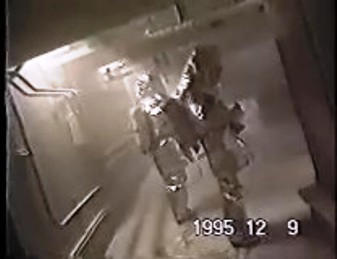The infamous Monju fast-breeder reactor leak of 1995, an accident that long ago earned itself a place in the history of nuclear power in Japan, has returned one more time to haunt government and industry officials with images they had hoped they would never see again.
Named after the Buddhist divinity of wisdom, Monju, located in Japan's Fukui prefecture, is Japan's only fast-breeder reactor. Unlike conventional reactors, fast-breeder reactors, which “breed” plutonium, use sodium rather than water as a coolant. This type of coolant creates a potentially hazardous situation as sodium is highly corrosive and reacts violently with both water and air.
On December 8th, 1995, 700 kg of molten sodium leaked from the secondary cooling circuit of the Monju reactor, resulting in a fire that made headlines across the country. Although the accident itself did not result in a radiation leak, many argue that the sodium spill itself came very close to detonating Monju, a catastrophe which would have spilled plutonium into the environment.
Following the fire, officials at the government-owned Power Reactor and Nuclear Fuel Development Corporation (PNC), operators of Monju, first played down the extent of damage at the reactor and denied the existence of a videotape showing the sodium spill. Later, they released still shots only, showing things like intact pipes and clean floors and claiming that there had only been “a minor leakage in the secondary sodium loop [that had] caused some fumes”. While short videos were released, these were edited to hide the full extent of the damage. Further complicating the story, the deputy general manager of the general affairs department at the PNC, Shigeo Nishimura, 49, jumped to his death the day after a news conference where he and other officials revealed the extent of the cover-up.
Starting from September of last year, Nishimura's family brought the story back to light in a trial against the PNC at Japan's High Court. It is in this context that a never-before-seen video (the so-called “2 o'clock video”), described in a 1996 New York Times article as “show[ing] men in silver space suits exploring the room in which sodium compounds hung from the air ducts like icicles”, has finally come out, released on YouTube by a group called News for the People in Japan (NPJ) and also posted by blogger tokyodo-2005 at his blog. Japanese subtitles have been translated to English and posted at dotSUB, as well as embedded in this article below.
The opening lines in the video provide some background:
「動燃が隠したもんじゅナトリウム漏れ事故直後の映像 いわゆる2時ビデオ」
もんじゅナトリウム漏れ事故の直後動燃は職員を現場に入れナトリウム漏れの映像を撮影していた。
しかし、そのあまりの生々しさに動燃はこれを隠した。
動燃は隠した理由は「価値がないから」と説明した。
Just after the accident, the PNC sent employees to the site to film the leak.
However, due to the graphic nature of the footage, the PNC hid it.
The PNC explained that they hid it because “it has no value”.
あなたの目でなぜ動燃がこのビデオを隠したのか、判断して欲しい。
このビデオがもんじゅ(福井県)に隠されただけでなく、本社にもコピーが持ち込まれて隠されていたことが後に発覚した。
その釈明会見で嘘を発表することになった職員は会見直後自殺した。
彼を自殺に追いやったのは何だったのか…。そのことも考えてほしい。
This video was not only hidden at Monju (Fukui Prefecture), it was also discovered later that there was another copy hidden at the head office.
An employee who had to lie at the press conference committed suicide right afterwards.
What was it that drove him to commit suicide… Think about this.

Snapshot from video showing pile of sodium under the leak.
In his blog entry, tokyodo-2005 goes into more detail about the video:
先日、この訴訟の口頭弁論が行われたが、西村さん側から大きな事実二つが主張された。
[…]
一つは、旧動燃が嘘をつき続けなければならなくなった2時ビデオの実態だ。
[…]
ナトリウムが漏れて小さな山のようにたまっている様子もはっきり撮影されており、これでは、旧動燃が隠したいと思うのも仕方ないと思えた。これが隠されたことによって、次から次へと嘘をつかざるを得なくなり、その嘘が外側から剥がれることによって、もんじゅ廃炉の声が高まった。先日の法廷での上映はその嘘の核となったビデオ、動燃が隠さざるを得なかったビデオの実態を伝えた。

Snapshot from video showing pile of sodium
事故が起きたのは、平成7年12月8日、ビデオが撮影されたのはそれから6時間後の9日午前2時、ダビングされたビデオが本 社に持ち込まれたのがその日の午後9時半。居合わせた社員はこれを視聴している。
[…]
ここで、西村さんは2時ビデオが本社に持ち込まれていたことが分かったのは、12月25日だと答える予定だったが、なぜか、1月10日だと答えてしまった。
[…]
そこで、西村さんは、自分で自分の口をふさぐしかなくなったのだろう。冒頭の遺書のようにすべてを自分のミスという形にして自殺した。
もんじゅはまもなく再開されようとしている。果たして西村さんを死に追いやった隠蔽体質は改善されているのか。少なくとも西村さんの裁判ですべてを明らかにして反省しようとする姿勢はまったく感じられない…。西村さんは命をかけて、ある意味、もんじゅを救ったが、西村さんは自分のような犠牲者が続くことは望んでいないはずだ。
More information about the re-opening of Monju can be found in this article at World Nuclear News.
[This article was co-written by Hanako Tokita.]
[Update (Jan. 28): More background to the trial mentioned in the article in this 2004 Japan Times article.]







2 comments